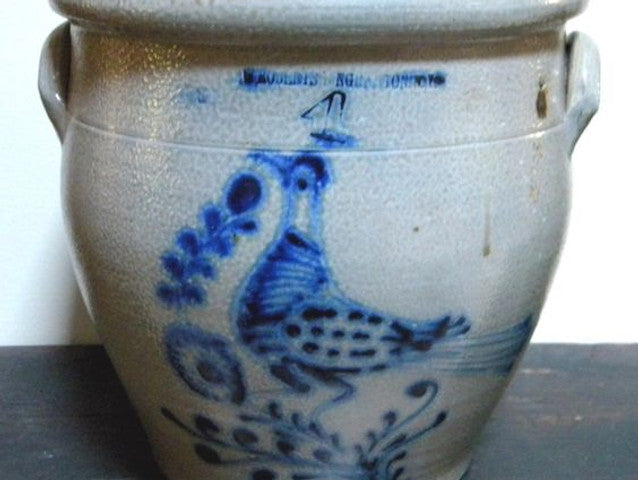
From the left, 4 Gallon Ovoid Crock from Binghamton, NY, circa 1850, #6 Ovoid Crock from Wakefield Studio, #6 Ovoid Crocks in production this spring.
Early American ovoid crocks are some of the most aesthetically pleasing shapes made by potters of the late 18th and early 19th century. They could range from having round and voluptuous proportions, to being more straight sided and down to business. Their business was food storage; everything from potted meats, to pickles or sauerkraut. Early 19th century ovoid crocks, especially from New York and Pennsylvania, often had elaborate or whimsical cobalt blue decorations. During my days making reproductions of early American stoneware at Rockdale Union Stoneware and Rowe Pottery Works, ovoids were always some of my favorite forms to make.
As a potter, the ovoid shape is one that is very satisfying to throw. Getting just the right amount of curve to the belly, the right strength and girth to the rim, with enough of an undercut to give it beautiful form, and also allow it to function well. (Crocks for food storage often had a piece of cheesecloth over the top, secured by a string tied around the neck of the pot). In the latter half of the 19th century, the generous ovoid shape gave way to straight sided crocks, which were easier to make in volume, and stacked more efficiently in the kiln.
Likewise, most garden pots have efficient, straight or flared sides, that facilitate repotting from a grower's pot, or transplanting to a larger pot. However, I've found that the ovoid shape also has benefits to accommodate a larger root ball, or the multiple root systems of a container garden.
Although trying to transplant from an ovoid pot might be a little more challenging, I think you'll enjoy to pleasing shape, and how it enhances your plantings.
Early American ovoid crocks are some of the most aesthetically pleasing shapes made by potters of the late 18th and early 19th century. They could range from having round and voluptuous proportions, to being more straight sided and down to business. Their business was food storage; everything from potted meats, to pickles or sauerkraut. Early 19th century ovoid crocks, especially from New York and Pennsylvania, often had elaborate or whimsical cobalt blue decorations. During my days making reproductions of early American stoneware at Rockdale Union Stoneware and Rowe Pottery Works, ovoids were always some of my favorite forms to make.
As a potter, the ovoid shape is one that is very satisfying to throw. Getting just the right amount of curve to the belly, the right strength and girth to the rim, with enough of an undercut to give it beautiful form, and also allow it to function well. (Crocks for food storage often had a piece of cheesecloth over the top, secured by a string tied around the neck of the pot). In the latter half of the 19th century, the generous ovoid shape gave way to straight sided crocks, which were easier to make in volume, and stacked more efficiently in the kiln.
Likewise, most garden pots have efficient, straight or flared sides, that facilitate repotting from a grower's pot, or transplanting to a larger pot. However, I've found that the ovoid shape also has benefits to accommodate a larger root ball, or the multiple root systems of a container garden.
Although trying to transplant from an ovoid pot might be a little more challenging, I think you'll enjoy to pleasing shape, and how it enhances your plantings.


Leave a comment
Also in Blog Posts
Patina on Terracotta Flowerpots
By Peter Wakefield Jackson January 13, 2023 1 Comment
Continue reading
Old English Watering Pots
By Peter Wakefield Jackson October 12, 2021 9 Comments
Continue reading
Centering Made Simple
By Peter Wakefield Jackson February 12, 2021 1 Comment
Continue reading